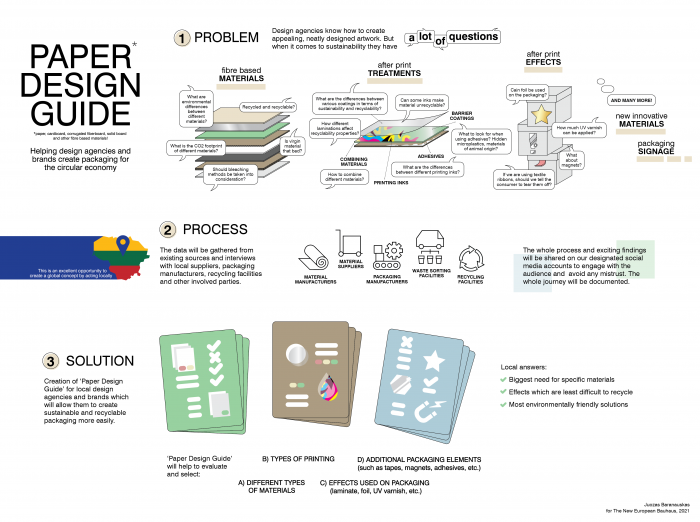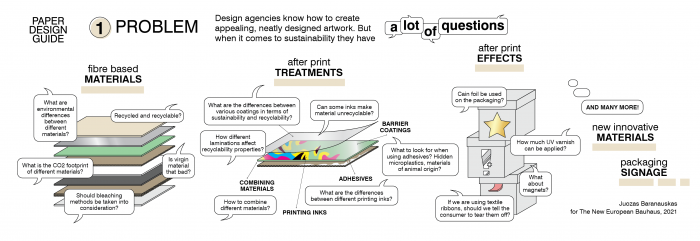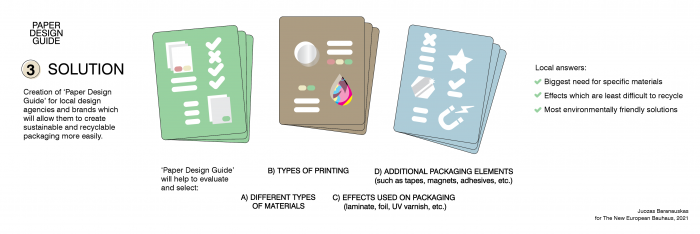I. SUMMARY INFORMATION
Project
269829
Status
Submitted
Award category
Interdisciplinary education models
You want to submit
NEW EUROPEAN BAUHAUS RISING STARS : concepts or ideas submitted by young talents (aged 30 or less)
Project title
Paper Design Guide
Full concept/idea title
Paper Design Guide: Helping design agencies and brands create packaging for the circular economy
Description
'Paper Design Guide' will allow local brands and design agencies to create sustainable and recyclable packaging more easily. The data will be gathered from existing sources and interviews with local suppliers, packaging manufacturers and recycling facilities. The guide will include information about materials, print, effects and other components that are 1) Most needed for Lithuanian recycling infrastructure 2) Least difficult to recycle 3) Most environmentally friendly.
Where is your concept/idea being developed or intended to be implemented in the EU?
Lithuania
Not Specified
Paeglines 2-oji st., 27
Vilnius
11305
II. DESCRIPTION OF THE PROJECT
Please provide a summary of your concept/ idea
Nowadays, we look at paper/cardboard packaging as a sustainable alternative to plastic packaging, but we forget that it is easy to make these materials unrecyclable. Therefore, instead of using a renewable resource at least 7 times more, we simply lose it in the form of smoke from waste incineration plants.
Today many designers don’t know what is a truly sustainable solution, and what is just greenwashing. For packaging to be truly recyclable, it must be suitable for local waste collection and recycling infrastructure. Even if SMEs and design agencies have the motivation to implement circular projects, they do not have the time and expertise to gather information and develop successful solutions.
Therefore, this project aims to create a ‘Paper Design Guide’ for Lithuanian brands and design agencies which would help to evaluate and select a) different types of materials; b) types of printing; c) effects used on packaging (laminate, foil, UV varnish, etc.) d) additional packaging elements, such as tapes, magnets, adhesives, etc. The main goal of this project is to present the following points on a website / PDF file / printed version in a clear and consistent manner. The guide should be easy to use on a day-to-day basis (both in Lithuanian and English).
I know that this ‘Paper Design Guide’ is necessary because I have been consulting design agencies and brands about this matter for a while now. 6 years ago I graduated with Design studies, and since then, I have worked for packaging manufacturers, interacted with material suppliers and led workshops about packaging sustainability. I know which parts of the paper packaging creation process bring the most confusion and lead to unsustainable, unrecyclable solutions. I noticed that a holistic problem-solving approach and communication between different players in an industry value chain can bring positive results both economically, socially, and environmentally, thus this guide could help a lot.
Please give information about the key objectives of your concept/idea in terms of sustainability and how these would be met
The main objective is to have better-designed packaging in Lithuania by design agencies and brands. ‘Better’ means:
1) Designed with recyclability in mind;
2) Produced with least harmful materials (recyclable, renewable, neutral to health);
3) After packaging improvements applied, packaging should stay at the same price category;
4) Because of these improvements design agencies/brands would be more competitive and resistant to new changes arising from customers and institutions
The guide will help to familiarize with existing local waste management and recycling infrastructure and will make it better by creating packaging that is as climate-neutral as possible and helps to create a circular economy, which is in line with SDG objective 9 - industry, innovation, and infrastructure.
We know that we will only achieve a climate-neutral economy if everyone contributes to its implementation, especially in urban areas, while encouraging designers to create sustainable solutions adapted to local conditions, which aligns with SDG 11- sustainable cities and communities. When our stores have the right choice of packaging that is at least recyclable, we will reduce our footprint consumption quickly, which is in line with SDG 12- responsible consumption and production.
The emergence of recyclable packaging will boost the circular economy and help keep materials in the system while at the same time helping to combat climate change, in line with SDG 13- tackling climate change. Most importantly, this guide will create synergies between different sectors and encourage further partnerships towards sustainability goals, which aligns with SDG 17 - partnership in achieving goals.
These goals could be achieved by developing a 'Paper Design Guide' because it could help to create more sustainable packaging throughout the life cycle in our region, which has the lowest circular use of products in the EU.
Please give information about the key objectives of your concept/idea in terms of aesthetics and quality of experience beyond functionality and how these would be met
Best designers know that true creativity comes with limitations, and I am witnessing this phenomenon every day. When working with design agencies and brands it is easy to notice that when there are restrictions due to environmental reasons, often projects turn into an interesting and unseen visual direction. This happens because due to limitations creative team members are encouraged to try new materials, inks, postprint effects and structural forms. So the final packaging solution is not only more sustainable but has a very distinctive design that helps to stand out from the competition and aesthetically win the hearts of customers.
When design agencies and brands succeed in creating recyclable packaging, they naturally want to communicate information about how and why to recycle this packaging to an end customer in a clear and educative manner by giving them a better understanding and raising their expectations towards other brands. Eventually, we can expect a snowball effect and see more and more design agencies and brands developing aesthetically more beautiful, sustainably better packaging projects.
Please give information about the key objectives of your concept/idea in terms of inclusion and how these would be been met
Inclusion is the central part of this project and will be in every stage of this project. This project will involve all stakeholders regardless of their gender, religion, physical ability, or political views. We will include everyone who will be eager to contribute to a more sustainable and transparent future. By enabling packaging designers and brand managers to create better packaging, change will reach everyone in the industry - material suppliers, manufacturers, waste sorting facilities, recycling facilities, and most importantly - end consumers. End consumers will get better packaging with more precise instructions on how to recycle it.
From a social point of view, this 'Paper Design Guide' will enable design agencies and brands to create sustainable packaging without wasting time, which will increase the social benefits for small and medium-sized enterprises. The end customer will remain the winner, as he will always know that packaging is designed for his region in the most sustainable way possible and will be sure that it could be recycled. This new situation could change the paradigm of consumerism in our society and create a whole new approach to the products placed on the market.
Please explain the innovative character of your concept/ idea
It is not only about the result (which is extremely important) but also, about the process. Most of us know that some poorly designed paper packaging can not be recycled for some reason. However, designers and brands don’t know the exact reasoning behind and they are scared to take the initiative to start changes. Why? Because they don’t know which solutions are only greenwashing and which are genuinely sustainable. We will share exciting findings in a designated social media accounts to engage with the audience and to avoid any mistrust, thus the whole journey will be documented.
Sustainability must be achieved from an environmental point of view and from an economic and social point of view as well. The economic innovativeness of this idea consists in the fact that it does not require significant investments. Still, the benefits are great because at the lowest possible cost - simply educating and giving up unsustainable packaging in terms of materiality, paint, adhesives, and so on. - the circular economy is being created, and only packaging that has a future appears on the market.
We need to build a circular economy not only globally but also locally. So this is an excellent opportunity to create a global concept by acting locally.
Please detail the plans you have for the further development, promotion and/or implementation of your concept/idea, with a particular attention to the initiatives to be taken before May 2022
Main project (before May 2022) → If this project will be awarded, I plan to dedicate about 3 months full-time to execute the interviews within the industry (waste sorting companies, recycle facilities, material suppliers and others). As well I plan to include other people and teams in this project on a payment basis as part-time contributors:
1) Circularity consultant and European Climate Pact ambassador Rasa Tumaševičiūtė to help check and compare data;
2) Editorial and graphic designer who will help with Guide preparation;
3) Web developer who will put all the information online.
Lastly, I plan to include other concerned parties who would like to contribute with their questions, answers, data or consultations (including design and marketing agencies).
After the project (after May 2022) → The possibilities of this idea are endless. If this project proves to help design agencies and brand managers to create better packaging, the same scheme could be easily adopted in other EU countries. During the process we will document every step, thus the methodology will be developed. Later the same tactics could be applied elsewhere, and by executing the same interviews elsewhere, Paper Design Guides could be developed for other countries or even bigger economic zones.
III. UPLOAD PICTURES
IV. VALIDATION
By ticking this box, you declare that all the information provided in this form is factually correct, that the proposed concept/idea has not been proposed for the New European Bauhaus Rising Stars Awards more than once in the same category.
Yes



